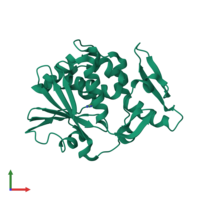 | |||||||
| Identifiers | |||||||
|---|---|---|---|---|---|---|---|
| Symbol | ? | ||||||
| Alt. names | α-Trichosanthin | ||||||
| CAS number | |||||||
| UniProt | P09989 | ||||||
| |||||||
Trichosanthin is a ribosome-inactivating protein. [1] [2] It is derived from Trichosanthes kirilowii . [3] It is also an abortifacient. [4]
 | |||||||
| Identifiers | |||||||
|---|---|---|---|---|---|---|---|
| Symbol | ? | ||||||
| Alt. names | α-Trichosanthin | ||||||
| CAS number | |||||||
| UniProt | P09989 | ||||||
| |||||||
Trichosanthin is a ribosome-inactivating protein. [1] [2] It is derived from Trichosanthes kirilowii . [3] It is also an abortifacient. [4]
Xenobiology (XB) is a subfield of synthetic biology, the study of synthesizing and manipulating biological devices and systems. The name "xenobiology" derives from the Greek word xenos, which means "stranger, alien". Xenobiology is a form of biology that is not (yet) familiar to science and is not found in nature. In practice, it describes novel biological systems and biochemistries that differ from the canonical DNA–RNA-20 amino acid system. For example, instead of DNA or RNA, XB explores nucleic acid analogues, termed xeno nucleic acid (XNA) as information carriers. It also focuses on an expanded genetic code and the incorporation of non-proteinogenic amino acids, or “xeno amino acids” into proteins.
In academia, computational immunology is a field of science that encompasses high-throughput genomic and bioinformatics approaches to immunology. The field's main aim is to convert immunological data into computational problems, solve these problems using mathematical and computational approaches and then convert these results into immunologically meaningful interpretations.
Chemokine ligands 4 previously known as macrophage inflammatory protein (MIP-1β), is a protein which in humans is encoded by the CCL4 gene. CCL4 belongs to a cluster of genes located on 17q11-q21 of the chromosomal region. Identification and localization of the gene on the chromosome 17 was in 1990 although the discovery of MIP-1 was initiated in 1988 with the purification of a protein doublet corresponding to inflammatory activity from supernatant of endotoxin-stimulated murine macrophages. At that time, it was also named as "macrophage inflammatory protein-1" (MIP-1) due to its inflammatory properties.

Chemokine ligand 8 (CCL8), also known as monocyte chemoattractant protein 2 (MCP2), is a protein that in humans is encoded by the CCL8 gene.

Eukaryotic translation termination factor 1 (eRF1), also known as TB3-1, is a protein that in humans is encoded by the ETF1 gene.

Y box binding protein 1 also known as Y-box transcription factor or nuclease-sensitive element-binding protein 1 is a protein that in humans is encoded by the YBX1 gene.

Interferon beta is a protein that in humans is encoded by the IFNB1 gene. The natural and recombinant protein forms have antiviral, antibacterial, and anticancer properties.

60S acidic ribosomal protein P0 is a protein that in humans is encoded by the RPLP0 gene.

Actin, gamma-enteric smooth muscle is a protein that in humans is encoded by the ACTG2 gene.

Cold shock domain-containing protein E1 is a protein that in humans is encoded by the CSDE1 gene.

Eukaryotic translation initiation factor 2 subunit 3 (eIF2γ) is a protein that in humans is encoded by the EIF2S3 gene.

60S ribosomal protein L7 is a protein that in humans is encoded by the RPL7 gene.

DNA-binding protein A is a protein that in humans is encoded by the CSDA gene.

CCAAT/enhancer-binding protein gamma (C/EBPγ) is a protein that in humans is encoded by the CEBPG gene. This gene has no introns.

60S ribosomal protein L36 is a protein that in humans is encoded by the RPL36 gene.

60S ribosomal protein L23 is a protein that in humans is encoded by the RPL23 gene.

40S ribosomal protein S28 is a protein that in humans is encoded by the RPS28 gene.

28S ribosomal protein S24, mitochondrial is a protein that in humans is encoded by the MRPS24 gene.

60S ribosomal protein L37a is a protein that in humans is encoded by the RPL37A gene.

A ribosome-inactivating protein (RIP) is a protein synthesis inhibitor that acts at the eukaryotic ribosome. This protein family describes a large family of such proteins that work by acting as rRNA N-glycosylase. They inactivate 60S ribosomal subunits by an N-glycosidic cleavage, which releases a specific adenine base from the sugar-phosphate backbone of 28S rRNA. RIPs exist in bacteria and plants.